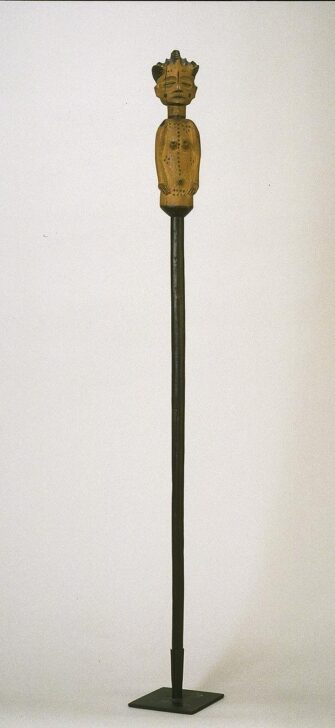Staff
Chokwe

Description
Subject Matter:
Among the Chokwe, who today live throughout Angola, Zambia, and the Democratic Republic of the Congo, carved staffs with figurative finials were the prerogative of chiefs. Known as mbweci (or mukombo), a chief’s staff was much more than a walking stick; it communicated his identity, status, and power through nuanced messages conveyed in its iconography.
The carved female figure featured at the finial of this chief’s staff represents a hamba (pl. mahamba), or the spirit of a lineage ancestor whose help the chief seeks for the welfare of the clan. Her depiction serves as a visual and tactile reminder that she continues to protect her descendants from the afterlife as she once did while alive.
A chief communicated his royal lineage by depicting particular female ancestors on his staff. In the royal court and beyond, this link with an ancestral past legitimizes and protects the chief’s claim to political authority. Furthermore, the maternal ancestor symbolizes fertility, maternity, progeny, and, above all, the continuation of the lineage — a primary concern of the chief and his clan.
Reference:
Staffs of Life: Rods, Staffs Scepters and Wands from the Coudron Collection of African Art. Ed.: Allen F. Roberts. Iowa City: PASALA: The Project for Advanced Study of Art and Life in Africa and the University of Iowa Museum of Art, 1994.
Physical Description:
This wooden Chokwe staff features a smooth, narrow rod and a large carving of a female figure at its finial. The female bears an elaborate, ridged coiffure, closed, coffee-bean shaped eyes, raised scarifications on her face, torso, and back, rounded shoulders, arms positioned down by her side, and a protruding navel.
Usage Rights:
If you are interested in using an image for a publication, please visit https://umma.umich.edu/request-image/ for more information and to fill out the online Image Rights and Reproductions Request Form.